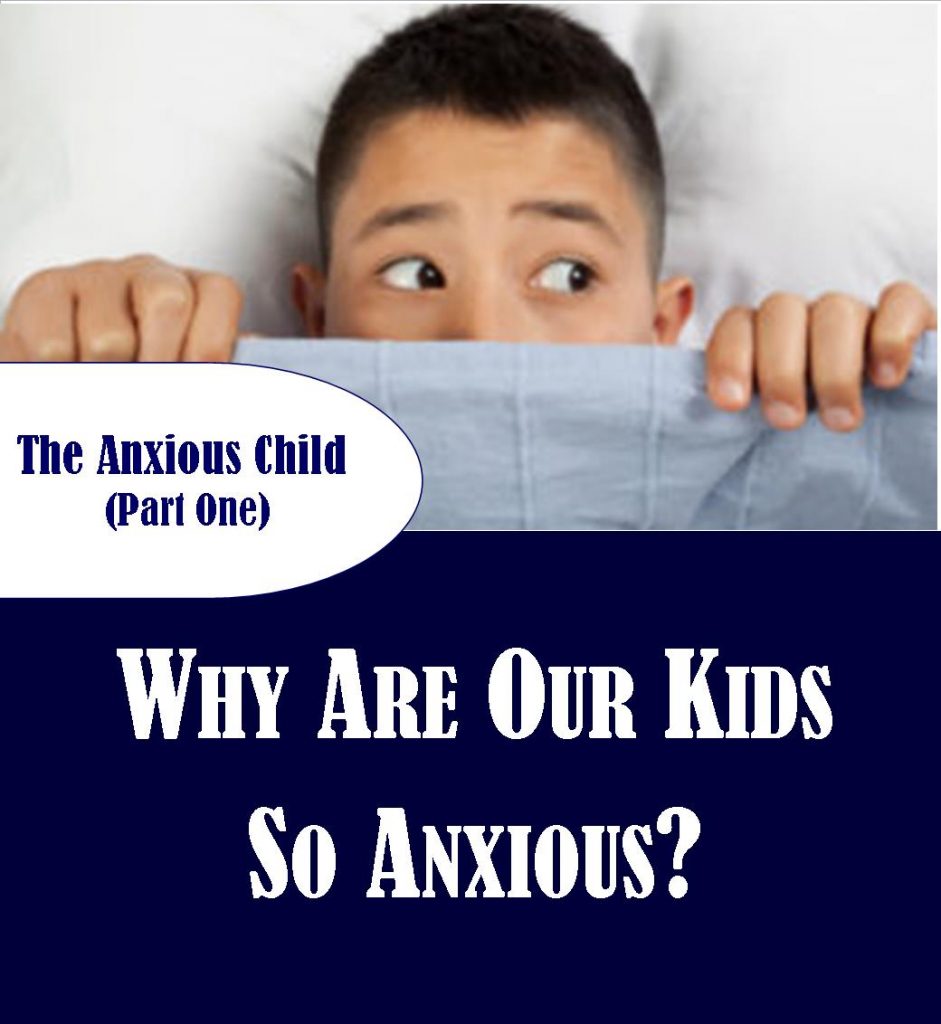
Many of us have kids who are anxious. We wonder whether it’s a problem. Being worried occasionally is a normal part of childhood (and adulthood). Kids feel nervous about the first day of school, they fear their friend won’t like them, they worry about their dog dying. We can’t protect our kids from all anxiety unless we want to live with them under a rock, and then our kids would be anxious about how to escape!
But we sense that something has shifted. Many children around us seem stuck in anxiety. All four of my children are anxious on occasion, but I have one child with serious, sometimes crippling anxiety. (I’m going to be gender neutral here to protect this child’s privacy.)
Please note, I am not a psychologist; I’m sharing with you some of what I’ve learned over the past few years as I’ve tried to understand anxiety so that I can help my child. Much of the theory informing my thinking comes from Gordon Neufeld, and particularly what I’ve learned through his classes at the Neufeld Institute. Dr. Neufeld’s approach may not appeal to you, and may not be what you’re looking for. So take with you what is helpful here, and feel free to leave behind what isn’t.
This is a 2-parter. Here, in part one, I’ll explain the difference between ordinary anxiety that happens to everybody and clinical anxiety that causes pain to some, including some kids. I’ll also explain a few possible causes of chronic anxiety in children. In part two, I’ll offer some tips for shielding our children from toxic levels of anxiety.
What Is Anxiety?
Anxiety is a sense of unease about some trigger: a child feels restless or unsafe for some reason. Anxiety is an activated alarm system. Just as the immune system protects us from disease, our alarm system keeps us safe and out of harm’s way. God gave us this alarm system on purpose; it’s not a mistake. Thank goodness our kids can feel anxious! If they never felt their alarm, they would run into roads and walk off with strangers.
Emotionally healthy children respond to an anxiety-provoking trigger by becoming cautious and conscientious. This is a very good thing. They learn to be wise and prudent. When they face these situations and overcome them, they build confidence and a sense of competence.
Healthy kids are anxious about different things. They are anxious about the unknown, about saying goodbye, about what’s under their beds. Sometimes kids are anxious about new experiences or facing a challenge. This is to be expected. As they mature, we can coach them in practicing the virtue of courage. Courage is not the absence of fear; it’s a proceeding toward a worthy goal or doing the right thing despite our fears. When kids can see the goal while admitting their fears, they are motivated to work past the fear to reach their goal. So I think helping a child find passions early in life is one of the best ways to help him overcome his anxieties about new experiences and challenges. Older kids and teens need to care about something to get through the natural anxieties of the teen years when they feel so self-conscious.
When Is Anxiety a Problem?
Although the alarm system is a gift that protects us, it can go haywire just like the immune system. In this case, our child’s alarm system can harm him, preventing him from maturing and thriving. When children become stuck in their anxiety, they are moved to hyper-caution, hyper-conscientiousness. Now they won’t become wise or prudent. They are stricken with an unrelenting sense that something bad is going to happen. They can have trouble sleeping and learning; they can become irritable or controlling.
Highly anxious kids often develop obsessions or compulsions to cope with their overwhelming alarm. These are maladaptive habits that they use to bring their anxiety down.
- They’re anxious about getting sick, so they develop obsessive cleaning rituals.
- They’re anxious about their appearance, so they develop obsessions about their weight or their grooming routine. They fear that if they miss one step in their routine, their world will come down around them.
- They’re anxious about looking dumb or failing, so they develop academic perfectionism and obsessive notetaking.
Children’s obsessions can build up until they are debilitating. My child who suffers from anxiety has “moving obsessions.” What this child is obsessed about seems to change with the seasons. For a long while, I tried to understand this child’s fears and obsessions rationally; I tried to explain to this child why these beliefs were irrational. Sometimes this child would listen, but often I was talking to a wall. Even when I made some headway in helping this child understand why the obsession was an illusion, it seemed the obsession would change to something different.
What’s At the Root of Problem Anxiety?
Why do some children become chronically anxious? Experts point to a number of factors that today’s children are living with that might contribute to the increase in clinical anxiety. Here are a few of them. I am necessarily simplifying what is a painful, complex problem for many families.
Over-Protective Parenting
Over-protective parents (sometimes called lawnmower parents or helicopter parents) are loving and well-meaning, but their approach can actually make their kids extremely anxious. I talk about helicopter parenting in this podcast.
When a parent is watching for signs of danger around a child, clearing the child’s path of obstacles, fixing the child’s mistakes, making excuses for the child when he fails, the message to the child is that the parent doesn’t trust him to handle things on his own. These children fail to develop grit or resilience when faced with setbacks or disappointment. Without grit and resilience, they can become stuck, their lives paused because they are afraid to move forward.
We have to give our kids permission to try things on their own, to fail, to strategize, and to start again. When we give our kids a chance to try hard things and to explore their passions, they will develop competence and an unstoppable zest for life.
Chaos
Children thrive on structure, rituals, and routines, especially at home. They provide kids with a sense of comfort and safety.
Having parents with predictable moods is also helpful, but you don’t have to be a Buddhist monk to raise healthy kids. Kids suffer when they are scared of us, when they don’t know what to expect from us because we are emotionally erratic. Now, for the love of Pete, don’t read too much into this. We’re all moody sometimes. Kids don’t need perfect parents, but they do need parents who generally make them feel safe.
When they know what’s happening, when they feel loved and safe with Mom and Dad, it frees them to play and explore. When every day is different, when they don’t know what to expect, it can make our children anxious.
Kids also become anxious when our families are over-scheduled. David Elkind warns parents about the costs of exposing our children to too much, too soon in The Hurried Child. Sports, math clubs, chess clubs, ballet are all great things for our kids to experience. But does our child have to do all these things at once? And at what age is it appropriate to begin these formal activities? Does a 3-year-old really need academic classes at all? Elkind says no. From his perspective, these hurried schedules inflict too much stress on our children. They don’t have enough unscheduled free time to sort through what they’re learning, to explore their own ideas, to live in their own heads for a while.
Whatever our lifestyle right now, we can ask ourselves whether our family’s pace of life is contributing to our child’s anxiety. Whether a child is living at home with two parents who are both working in the paid workforce, with one parent who is the sole breadwinner, or with one parent who works outside the house while the other parent stays home, we can take a look at our schedule to ensure our child has enough downtime at home.
Separation
In several of the courses I’ve taken with Gordon Neufeld, he mentioned that beneath most irrational anxiety is a fear of separation. I couldn’t understand this initially. How is a child’s fear of touching germs rooted in a fear of separation?
Here’s what I eventually figured out. The germs, the perfect looks, the perfect grades? For some kids, these are a smoke screen for the real issue, which is a fear of separation of some kind. In my work with my child with the moving obsessions, I realized eventually that I was trying to understand the symptom rather than the real problem. This child’s obsessions were a veil for what was mostly an attachment problem.
Attachment creates the womb of maturation. When our children are securely attached to us, they can rest in the relationship. From this place of rest, maturation happens: they develop their sense of identity, they explore the world around them, they ask questions and search for answers. When our children are attached to us, they feel a secure base in the relationship, and this gives them the power to burst forth and chart their course in life.
When our children are exposed to more separation than they can bear, they become preoccupied with searching, seeking, yearning for that sense of safety and connection. They become less independent and more anxious. They become fixated on substitute attachments (peers, technology) or they become stuck in self-numbing behaviors.
When Dr. Neufeld refers to separation, he is not only referring to physical separation. There are six roots or paths of secure, enduring attachment. (I talk about these 6 roots here.) Children yearn for connection to us through more than physical closeness. They connect through sameness (I look like you, I talk like you), belonging (this is my family, I belong here), significance (I’m important to you), emotional intimacy (you love me and I love you), and psychological intimacy (you understand me).
Children can become wounded in any of these attachment areas, creating a feeling of dread or fear within them. When they sense they are not welcome, that they don’t belong, that they are not important, it sets off their alarm system. This can happen with their peers, and then we are the safe harbor leading them back home to themselves and they find emotional peace again. But when the wounding happens at home, our children have no safe harbor, no place to return to emotional equilibrium.
When a child is faced with a separation that is too much to bear, perhaps parental rejection, the brain works to find an explanation, and the child gloms onto something they can control, whatever it might be. This is why the obsessions are often not the root cause of the anxiety. A child who is obsessed with her appearance? The perfect hair and make-up are usually a mask for a deep-seated fear that she doesn’t belong, that she’s not the same as, that she’s not lovable, that nobody knows her. We can explain the irrationality of their beliefs about physical beauty, but the root cause is one of attachment, not over-grooming.
Now that we have a handle on what anxiety is and a few reasons anxiety disorders might develop, in my next article, I’ll offer some ideas for protecting kids from excessive anxiety.

